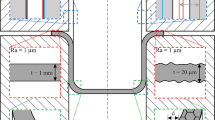Abstract
The article discusses some techniques for the determination of ideal (or optimum) blank contours when deep drawing prismatic cups. The ideal contours are designed to produce essentially flat topped cups and thus trimming of excess material is minimized. The techniques lend themselves to such processes where the cups are drawn from initially flat blanks in the presence of a blank holder. Tooling which involves lock beads or draw beads is not considered.
Attention is devoted to two techniques developed by the authors; each method is based on the solution of Laplace’s equation. One technique is experimental and uses an electrostatic analogue, the second is numerical and the solution procedure employs the boundary element method. Neither method attempts a rigorous analysis of the actual drawing operation. They are intended as a means of producing near-net shaped blanks with little computational effort. Since material costs usually represent a major portion of the overall cost of a sheet metal part, the theme of the paper has immediate practical significance.
Similar content being viewed by others
References
R.D. Wood, K. Mattiasson, M.E. Honner, and O.C. Zienkowicz (1986). Viscous Flow and Solid Mechanics Approaches to the Analysis of Thin Sheet Forming, inComputer Modeling of Sheet Metal Forming Proesses (Eds. N-M. Wang and S.C. Tang), pp. 121–130, The Metallurgical Society, Warrendale, Pennsylvania.
C.H. Toh and S. Kobayashi (1985). Deformation Analysis and Blank Design in Square Cup Drawing,Int. J. Machine Tool Design and Res., Vol. 25, pp. 15–32.
H. Iseki and T. Murota (1984). Analysis of Deep Drawing of Non-Axisymmetric Cups by the Finite Element Method, Proc. 1st ICTP, pp. 678–684, Tokyo.
W. Johnson, R. Sowerby, and R.D. Venter (1982).Plane Strain Slip Line Fields for Metal Deformation Processes, Pergamon Press, Oxford, U.K.
T. Jimma (1970). Deep Drawing of Convex Polygon-Shells,J. Japan Soc. Technology for Plasticity, Vol. 11, pp. 653–660 (in Japanese).
V. V. Hazek and K. Lange (1979). Use of the Slip Line Field Method in Deep Drawing Large Irregular Shaped Components, Proc. 7th NAMRC, pp. 65–71, SME.
H. Gloeckl and K. Lange (1983). Computer Aided Design of Blanks for Deep Drawn Irregular Shaped Components, Proc. 11th NAMRC, pp. 243–251, SME.
R. Sowerby, N. Chandrasekaren, X. Chen, M. Rooks, and P. Correa (1988), The Development of Computer Aids for Sheet Metal Stampings, inCAD/CAM and FEM in Metalworking, S.K. Ghosh and A. Niku-Lari, eds., pp. 187–203, Pergamon Press.
W. Karplus (1958).Analog Simulation, McGraw-Hill Co., New York.
W. Karplus and W.W. Soroka (1959).Analog Methods, McGraw-Hill Co., New York.
Z. Zhaotao and L. Bingwen (1986). Determination of Blank Shapes for Drawing Irregular Cups Using an Electrical Analogue Method,Int. J. Mech. Sci., Vol. 28, pp. 499–503.
A.R. Boothroyd, E.C. Cherry, and R. Maker (1949). An Electrolytic Tank for the Measurement of Steady-State Response, Transient Response and Allied Properties of Networks, Proc. IEEE, Vol. 96, pp. 163–170.
E. Weber (1950).Electromagnetic Fields: Vol. 1, Mapping of Fields, John Wiley and Sons, New York.
C.A. Brebbia (1978).The Boundary Element Method for Engineers, Halsted Press, New York.
C.A. Brebbia, J.C.F. Telles, and L.C. Wrobel (1984).Boundary Element Techniques, Springer-Verlag, Berlin.
G.S. Gipson (1987).Boundary Element Fundamentals, Computational Mechanics Publications, Southampton, U.K.
Author information
Authors and Affiliations
Rights and permissions
About this article
Cite this article
Liu, F., Sowerby, R. The determination of optimum blank shapes when deep drawing prismatic cups. J. Mater. Shaping Technol. 9, 153–159 (1991). https://doi.org/10.1007/BF02834685
Issue Date:
DOI: https://doi.org/10.1007/BF02834685




